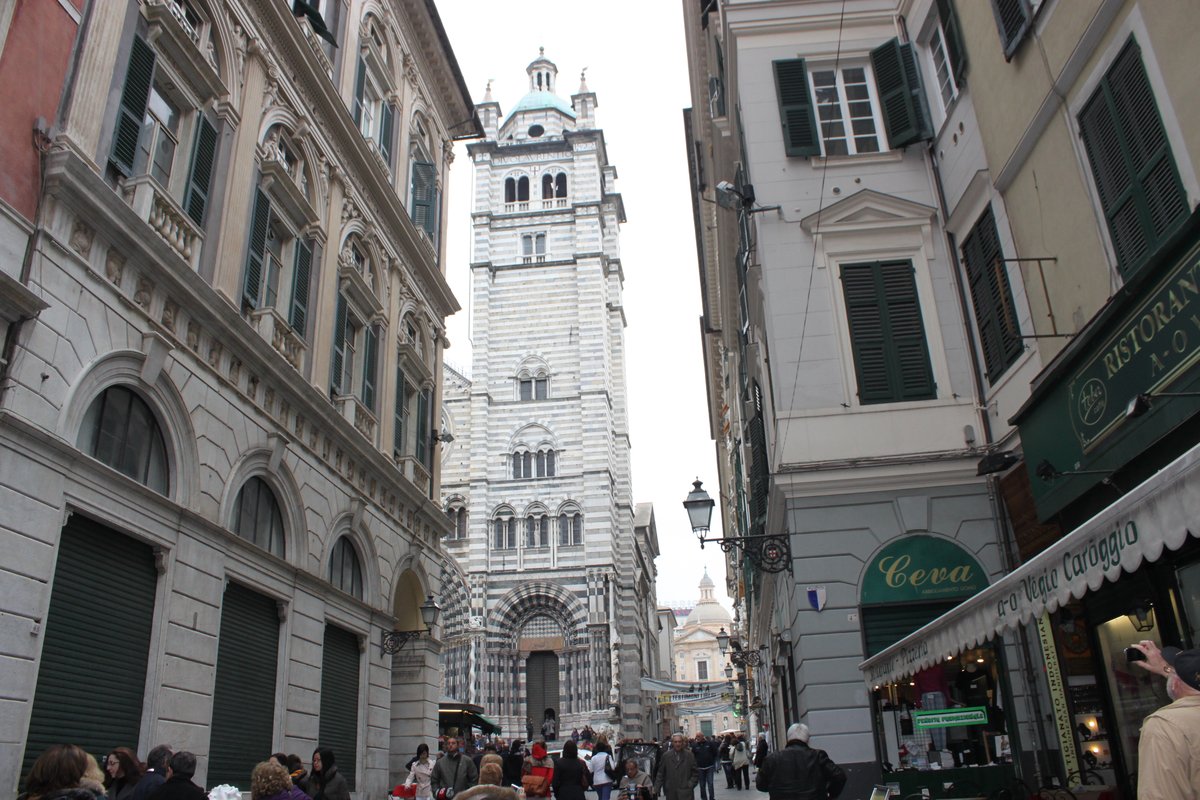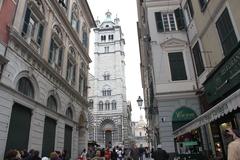
Genoa Cathedral Visiting Hours, Tickets, and Historical Sites Guide
Date: 14/06/2025
Introduction
Genoa Cathedral, officially known as the Cattedrale di San Lorenzo, is one of the most significant landmarks in Genoa, Italy. With its roots tracing back to early Christianity, the cathedral has stood as a center of faith, culture, and civic life through centuries of Genoese history. Noted for its striking black-and-white striped marble façade, intricate interior artworks, and its role as the city’s religious heart, Genoa Cathedral is a must-visit for travelers interested in architecture, history, and art. This guide provides a detailed overview of the cathedral’s history, architectural features, visiting hours, ticketing, accessibility information, and practical tips for a memorable visit.
For further planning, refer to the Cattedrale di San Lorenzo and Visit Genoa official resources.
Historical Overview
Early Origins and Foundation
The foundation of Genoa Cathedral dates back to the 5th or 6th century, when a basilica dedicated to Saint Syrus was established on this site. As Genoa’s maritime prominence grew, the city sought to build a grander place of worship. In the late 11th century, construction began on a new cathedral, marking Genoa’s religious and civic aspirations. Consecrated by Pope Gelasius II in 1118, San Lorenzo quickly became the focal point for religious and public life in the city (Italy Magazine).
Romanesque Beginnings and Medieval Expansion
The cathedral’s earliest sections, built in the Romanesque style, are characterized by rounded arches and thick stone walls. The 12th and 13th centuries saw the addition of side naves and chapels, funded largely by wealth from Genoa’s trade and the Crusades. The iconic black-and-white marble façade, a symbol of Genoese nobility and craftsmanship, was completed in the early 14th century (Cultural Italy).
Gothic, Renaissance, and Baroque Transformations
After a fire in 1296, the cathedral was rebuilt and expanded with Gothic features, notably the pointed arches, impressive portals, and detailed sculptural work by French craftsmen. The 16th-century brought Renaissance influences, including the dome and bell tower, while the 17th century ushered in Baroque embellishments such as frescoes and gilded stuccoes (Rough Guides).
Modern Restorations
Significant restorations in the 19th and 20th centuries have preserved the cathedral’s distinctive character. Notable features from this period include the marble lions at the entrance, sculpted in 1840, and the ongoing maintenance that secures the cathedral’s future as a living monument.
Architectural Highlights
Façade and Towers
The cathedral’s façade, completed in 1312, is famous for its alternating bands of black and white marble—a visual signature of Ligurian Gothic architecture. The asymmetrical towers reflect centuries of construction: the right bell tower (completed in 1522) rises to 60 meters, while the left remains unfinished (Cultural Italy).
Portals and Sculpture
Three elaborately carved Gothic portals, created by French artisans, depict biblical scenes and saints. Two marble lions by Carlo Rubatto guard the entrance, symbolizing strength and vigilance (Cultural Italy).
Interior Spaces
Inside, the cathedral boasts a majestic nave, high vaults, and columns adorned with striped marble. The Renaissance dome admits natural light, illuminating mosaics and frescoes by artists such as Luca Cambiaso and Lazzaro Tavarone. The rose window and early 14th-century capitals with intricate foliage and animal motifs enrich the space (Evendo).
Chapels and Relics
The Chapel of St. John the Baptist houses relics of the saint, including what tradition holds to be his ashes. The chapel features vivid frescoes by Perin del Vaga and is central to the cathedral’s spiritual significance (TravelSetu).
The Museum of the Treasure (Museo del Tesoro)
Beneath the cathedral, the Museo del Tesoro di San Lorenzo presents sacred relics, including the famed Sacro Catino—a green glass dish once believed to be the Holy Grail—alongside liturgical objects and precious artifacts (Next Level of Travel).
Visitor Information
Genoa Cathedral Visiting Hours
- Monday to Saturday: 9:00 AM – 6:00 PM
- Sunday and Religious Holidays: 12:00 PM – 6:00 PM
- Note: Hours may vary during special events or religious ceremonies. Always check the official website before visiting.
Tickets and Admission
- Cathedral Entry: Free
- Museo del Tesoro: Admission required, typically around €6
- Guided Tours: Available in multiple languages for an additional fee; recommended booking in advance (Visit Genoa)
Accessibility
- Ramps at the main and side entrances ensure wheelchair access.
- Assistance is available upon request; notify staff in advance for special accommodation.
Dress Code and Etiquette
- Modest dress is required: cover shoulders and knees, and remove hats.
- Maintain silence during services and respect ongoing worship.
Photography and Media
- Photography is permitted inside, but avoid flash and tripods.
- Share photos on social media with #GenoaCathedral to connect with other visitors.
Facilities
- Restrooms are available on-site.
- The cathedral is surrounded by cafes and restaurants for refreshments.
Nearby Attractions
- Piazza San Lorenzo: The central square hosting the cathedral.
- Palazzo Ducale: The historic ducal palace, a short walk away.
- Via Garibaldi: UNESCO-listed street renowned for Renaissance palaces.
- Porto Antico: The revitalized Old Port area with museums and dining (Sightseeing Experience).
Notable Features and Anecdotes
- WWII Bomb: An unexploded British bomb from 1941 is displayed inside as a symbol of resilience (Amongst Romans).
- The “Lucky Dog”: A carved dog on the façade is said to bring good luck to those who find it.
- Cultural Events: The cathedral hosts concerts and religious festivals, especially during the feast of St. John the Baptist on June 24th (Visit Genoa).
Practical Visiting Tips
- Best Time: Early morning or late afternoon is less crowded.
- Weather: Genoa is mild in June, but check forecasts and bring an umbrella in spring/autumn (Weather25).
- Safety: The historic center is safe, but stay aware after dark (Discover Northern Italy).
- Combine Visits: Plan to see nearby sites, sample Ligurian cuisine, and explore the medieval alleys (Savoring Italy).
Frequently Asked Questions (FAQs)
Q: What are the Genoa Cathedral visiting hours?
A: Generally, Monday–Saturday 9:00 AM–6:00 PM, Sundays 12:00 PM–6:00 PM; hours may vary.
Q: Is there an entrance fee?
A: Entry to the cathedral is free; the Museo del Tesoro requires a ticket.
Q: Are guided tours available?
A: Yes, in multiple languages. Booking in advance is recommended.
Q: Is the cathedral accessible for wheelchair users?
A: Yes, ramps and assistance are provided.
Q: Can I take photos inside?
A: Yes, but avoid flash and tripods to protect the artworks.
Location and Getting There
Genoa Cathedral is located on Via San Lorenzo, in the heart of Genoa’s historic old town. It is a short walk from Piazza De Ferrari, the Old Port, and other major attractions. The area is well-connected by public transport and pedestrian-friendly (That Travelista).
Unique Experiences
- Attend a Mass: Participate in a religious service for insight into local traditions.
- Explore the Museo del Tesoro: Discover sacred relics and legends, including the Sacro Catino.
- Join a Guided Tour: Deepen your understanding of Genoese history and art.
- Capture the Light: The striped façade and stained-glass windows are especially photogenic in the afternoon.
Conclusion
Genoa Cathedral is an architectural and spiritual gem at the heart of Genoa’s UNESCO-listed historic center. Its layered styles reflect centuries of history, from Romanesque beginnings to Gothic, Renaissance, and Baroque flourishes. As a living place of worship and a testament to Genoa’s rich heritage, the cathedral offers an immersive journey through art, faith, and culture. Make sure to check updated visiting hours, respect the cathedral’s etiquette, and consider joining a guided tour for a truly memorable experience.
For detailed updates, official information, and virtual tours, consult the Cattedrale di San Lorenzo and Visit Genoa websites. Enhance your visit with the Audiala app for expert audio commentary and offline maps.
Related Articles and Resources
- Official Genoa Cathedral Website
- Visit Genoa Tourism Page
- Italy Magazine: Genoa Cathedral Guide
- Rough Guides: Genoa Travel Information
- Cultural Italy: Duomo di Genova Features
- Wandering Liguria: Genoa City of Art and Culture
- Sightseeing Experience: Exploring Genoa Attractions
- Next Level of Travel: Top Places to See in Genoa
- Evendo: Cattedrale di San Lorenzo Details
- TravelSetu: Genoa Cathedral Tourism Guide
- Amongst Romans: Guide to Visiting Genoa



































































































